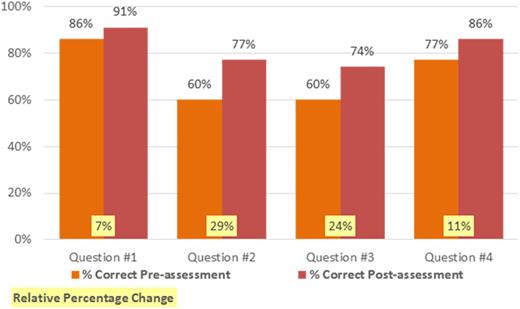Abstract
Introduction/Background: Novel approaches for the post-autologous hematopoietic stem cell transplantation (auto-HSCT) consolidation treatment now exist for patients with classical Hodgkin lymphoma (HL) at high risk of relapse or progression. This advancement can potentially reduce the frequency of disease progression following autologous stem cell transplantation (ASCT) for certain patients at high risk. However, before such treatment can be administered, hematologists must appropriatelyrecognize and apply prognostic factors to identify patients at risk who would benefit from such treatment.
Materials and Methods: We developed an online CME initiative that aimed to match each leaner with needed education as determined by his/her baseline competency and skill level. This tailored-learning approach used a single case-based screening question to segment the participants based on their knowledge regarding risk stratification of patients with HL. Hematologists who incorrectly answered the screening question were directed to Activity 1 - Interpreting Risk Factors for Post-Transplantation Relapse in Hodgkin Lymphoma (http://www.medscape.org/viewarticle/842624). Those who correctly identified a patient at risk for post-ASCT relapse were directed to Activity 2 - Post-Autologous Transplantation Therapy for Hodgkin Lymphoma (http://www.medscape.org/viewarticle/842640). . Online survey instruments using knowledge- and case-based, multiple-choice questions were administered to compare the same participants' responses to identical questions before and after each activity. McNemar's chi-squared test was used to determine statistical significance between responses. The initiative launched on June 1, 2015 and data collected through October 23, 2015.
Results: 1600 hematologists answered the case-based screening question; 74% of hematologists answered incorrectly and were directed to Activity 1, indicating a deficit in understanding which patients would benefit from consolidation treatment in HL. Among hematologists who participated in Activity 1 and completed all pre- and post-assessment questions during the study duration (n=272), comparison of individually linked pre-assessment question responses to the respective post-assessment question responses demonstrates statistically significant improvements in knowledge (P <.05) on appropriate treatments for patients with HL who have received HDT/ASCT, and ways to optimize outcomes for those receiving consolidation/maintenance therapy. Correct responses on post-assessment questions were up to 48% higher after CME completion (compared with the pre-assessment question responses) with an overall medium effect size of d=0.621 [Figure 1]. Among those who were directed to Activity 2 (26% of learners) and completed all pre- and post-assessment questions (n=37), there was 26% increase in recognition that treatment with brentuximab vedotin consistently improved progression-free survival across all prespecified subgroups [Figure 2].
Conclusions: This study demonstrated the success in using online branching logic to segment the participants based on a screening question to identify presence or absence of a specific knowledge gap in hematologist learners. Participation in this initiative led to the identification of large group of learners who benefited from segmented learning. Recognizing that individual hematologists are at various stages of understanding of best practices in managing HL, this approach may be used to maximize translation of evidence-based recommendations into clinical decisions.
Activity 1: Interpreting Risk Factors for Post-Transplantation Relapse in Hodgkin Lymphoma
Activity 1: Interpreting Risk Factors for Post-Transplantation Relapse in Hodgkin Lymphoma
Activity 2: Post-Autologous Transplantation Therapy for Hodgkin Lymphoma
Activity 2: Post-Autologous Transplantation Therapy for Hodgkin Lymphoma
No relevant conflicts of interest to declare.
Author notes
Asterisk with author names denotes non-ASH members.



